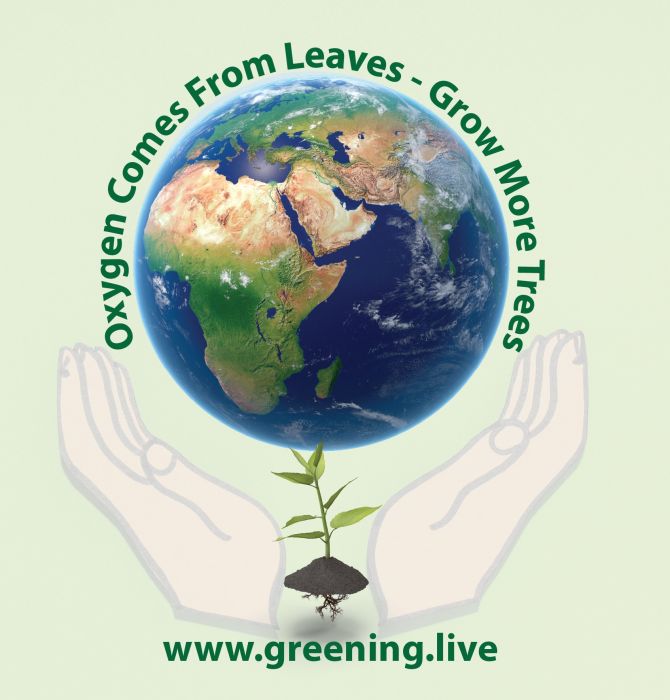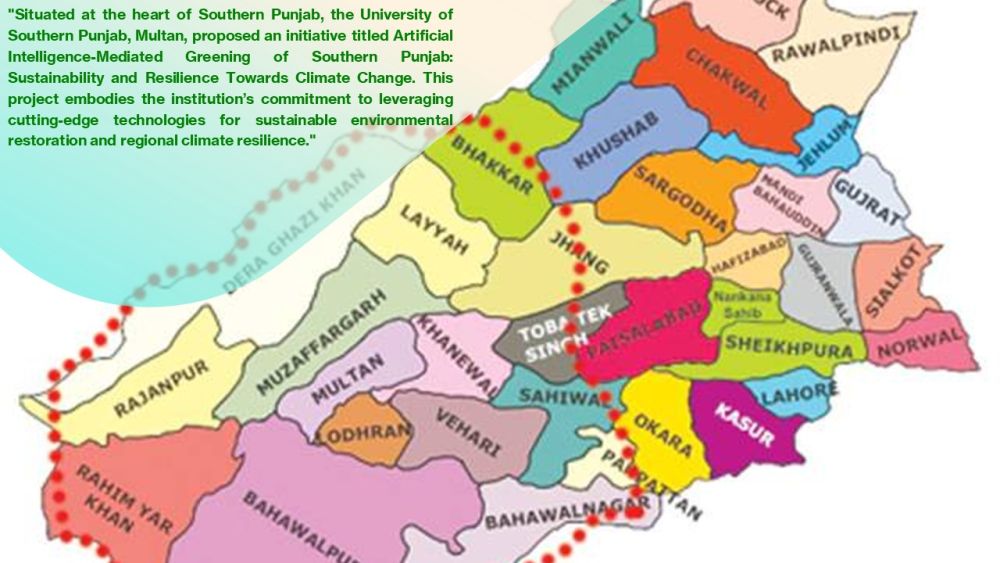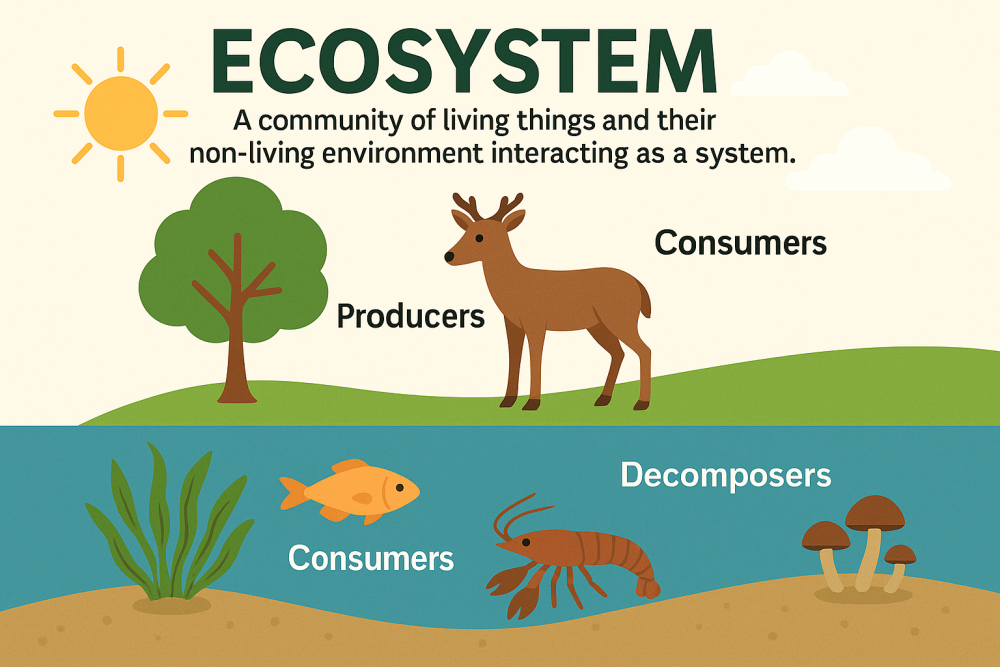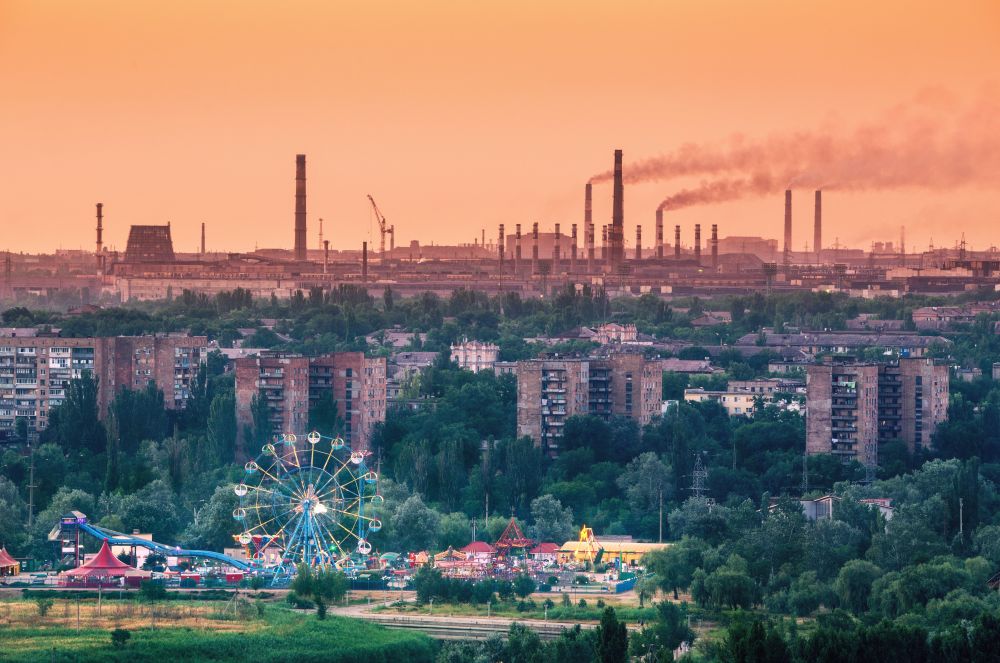69/25 Lecture 3B - Systems, Human–Environment Interaction, and Sustainable Living
Posted 1 month ago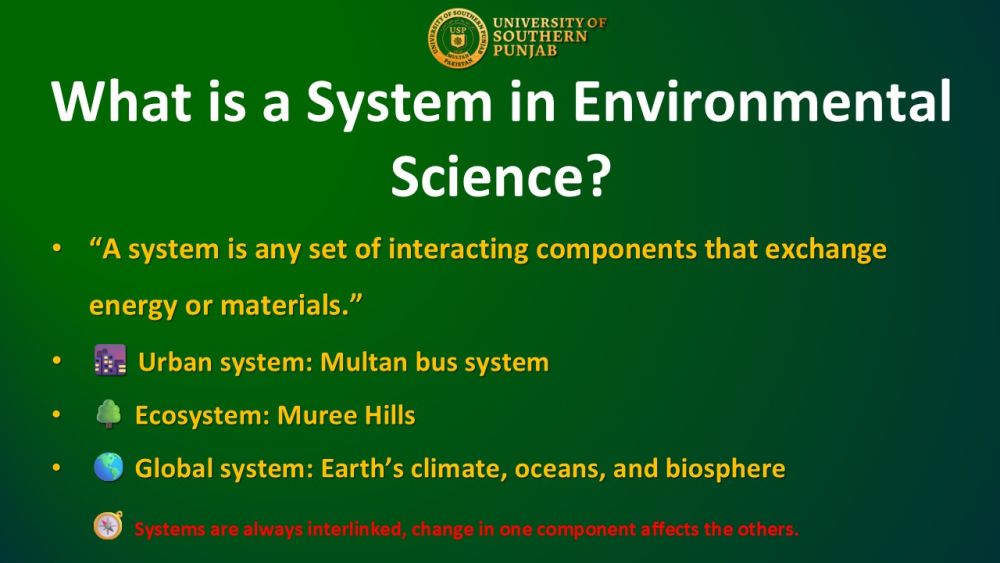
For Lecture 3B Video Click HERE
🌍 Lecture Notes
Systems, Human–Environment Interaction, and Sustainable Living
What is a System in Environmental Science?
Lecture Narrative
Today, we step into one of the most fascinating ideas in environmental science, the concept of a system. A system is any interacting component that exchanges energy, materials, or information. Think of it as a team: every member has a specific role, and together, they create a functioning whole.
In environmental science, systems can be natural (like forests, rivers, or the atmosphere) or human-made (such as cities, transportation networks, or industries). What makes systems remarkable is that they are interconnected — a change in one component can influence the entire system.
Let’s make this real.
Imagine the urban transport system of a city like Multan.
- Buses, roads, passengers, traffic signals, and fuel supply all coordinate.
- If one part fails, say, buses break down, or fuel prices rise, the entire network feels the impact.
Now compare that to a natural ecosystem, such as the Murree Hills.
- Here, trees, animals, soil, water, and climate continuously interact.
- Remove one element, cut down trees, for instance, and you affect water cycles, soil stability, and local wildlife.
On a global scale, the Earth is a system; the climate, oceans, and biosphere operate as interlinked subsystems. A change in one, such as increased greenhouse gas emissions, reverberates through all others.
Understanding systems thinking allows us to appreciate the ripple effect of human actions. In environmental science, this perspective is crucial. It teaches us not only how things connect but also how small disruptions can lead to major consequences.
Key Concepts
- System: A set of interacting components exchanging energy or matter.
- Ecosystem: A biological community interacting with its physical environment.
- Feedback Loops: Processes that amplify (positive feedback) or dampen (negative feedback) change.
- Interconnectedness: No part of the environment operates in isolation.
Example
When glaciers melt in the Himalayas, it affects river flow in Pakistan, agriculture in Punjab, and even fish habitats downstream. A local event becomes a global system issue.
Human–Environment Interaction
Lecture Narrative
Every moment of our lives is intertwined with the environment. When we eat, we depend on soil, water, and biodiversity. When we turn on a light, we rely on natural resources, such as coal, gas, or solar energy.
This relationship is twofold: We depend on the environment, but we also reshape it. Urbanization, industrialization, and modern agriculture alter landscapes, release pollutants, and change ecosystems.
Environmental science, therefore, is the science of connections; it reveals how human choices influence air quality, water safety, soil fertility, and even the stability of the global climate.
The message is clear: protecting the environment is not just about nature; it’s about protecting ourselves. Clean air means fewer respiratory diseases, safe water means better health, and stable climates mean secure food supplies.
Environmental literacy helps us recognize that our personal and collective well-being depends on maintaining a healthy environment.
Key Concepts
- Human dependency: Air, water, and soil sustain all human activity.
- Two-way relationship: Humans shape the environment; the environment shapes humans.
- Ecosystem services: Benefits provided by natural systems—clean water, pollination, climate regulation, etc.
- Anthropogenic impact: Human-caused environmental changes.
Example
Building a dam can provide irrigation and power, but may also flood forests, displace communities, and affect fish migration. The human–environment interaction is always a story of trade-offs.
The Importance of Environmental Science
Lecture Narrative
At the heart of Environmental Science lies a fundamental question:
Are human activities damaging the systems that support life on Earth?
The discipline addresses how we use vital resources, such as water, soil, minerals, and energy, and how our patterns of consumption generate waste and pollution.
Let’s examine some critical impact areas:
- Pollution: Airborne particles cause smog and respiratory disease.
- Biodiversity loss: Species extinction weakens ecosystems.
- Climate change: Rising temperatures disrupt food and water systems.
Yet environmental science's purpose is not to halt human progress but to guide it wisely. We aim to find the equilibrium between human advancement and ecological health, what we call sustainable development.
Through environmental understanding, we learn to use resources prudently, design cleaner technologies, and restore degraded environments.
Key Concepts
- Resource management: Rational use of natural assets for long-term benefit.
- Pollution control: Prevention and remediation strategies.
- Biodiversity conservation: Protection of ecosystems and species diversity.
- Climate resilience: Adaptive capacity to cope with environmental change.
Example
China’s shift toward renewable energy demonstrates how environmental science informs policy. Scientific understanding guides decisions that reduce pollution while maintaining economic growth.
Sustainable Living
Lecture Narrative
Finally, let’s discuss a concept that ties all our learning together — sustainable living.
Sustainability asks a deceptively simple question:
Are we using Earth’s resources in ways that allow future generations to live as well as we do today?
This question challenges us to rethink everything, from consuming energy and food to designing cities and industries.
Sustainable living involves:
- Using resources responsibly, ensuring they are renewable or replenishable.
- Transitioning to renewable energy sources like solar and wind.
- Conserving ecosystems and biodiversity, protecting forests, oceans, and species.
- Practicing environmental ethics—making choices guided by fairness, stewardship, and intergenerational justice.
Importantly, sustainability is not a restriction; it’s a wise, forward-looking approach that envisions prosperity and progress that respects ecological limits.
As future scientists, policymakers, or citizens, your challenge will be to align innovation with integrity, to ensure that human and natural systems can thrive together in harmony.
Key Concepts
- Sustainability: Meeting present needs without compromising future generations.
- Renewable resources: Energy sources that replenish naturally.
- Environmental ethics: Moral framework guiding environmental decisions.
- Intergenerational equity: Fairness between present and future generations.
Example
Planting trees in urban areas may seem small, but it enhances air quality, moderates temperature, and supports mental health. Sustainable living begins with mindful, local actions that ripple globally.
🧩 Examination Section
Section A - Multiple Choice Questions
- A system in environmental science can best be defined as:
A. A collection of living organisms only
B. A set of interacting parts exchanging energy or materials
C. A closed structure unaffected by external forces
D. A social institution managing pollution
✅ Answer: B - Which of the following best represents a feedback loop?
A. Students studying for exams
B. Trees absorbing carbon dioxide and influencing climate
C. A dam producing electricity
D. Buses operating on a schedule
✅ Answer: B - Which of the following is a principle of sustainable living?
A. Using all available resources for present growth
B. Relying entirely on fossil fuels
C. Meeting present needs without harming future generations
D. Ignoring biodiversity
✅ Answer: C - Which human activity most directly affects the global climate system?
A. Reading books
B. Greenhouse gas emissions
C. Ocean tides
D. Seasonal farming
✅ Answer: B
Section B - Short Answer Questions
- Define a system and give one environmental example.
✅ Answer: A system is a group of interacting components that exchange energy or materials. Example: A forest ecosystem where plants, animals, and soil interact to maintain balance. - What does human–environment interaction mean?
✅ Answer: It refers to the mutual relationship in which humans depend on natural resources and simultaneously modify the environment through their activities. - List three principles of sustainable living.
✅ Answer: (1) Responsible resource use, (2) Transition to renewable energy, (3) Conservation of ecosystems and biodiversity.
Section C - Long Essay Questions
- Discuss the importance of systems thinking in understanding environmental problems.
✅ Answer:
Systems thinking recognizes that environmental issues are interconnected. For example, deforestation simultaneously affects climate, water cycles, and biodiversity. By understanding feedback loops and interdependencies, scientists can design holistic solutions. Systems thinking shifts focus from isolated problems to the dynamics of entire ecological networks, leading to more effective and sustainable interventions. - Explain how human-environment interactions shape natural and human systems. Provide examples.
✅ Answer:
Humans rely on the environment for food, water, and energy. However, activities like urbanization and industrialization alter ecosystems and climate patterns. For instance, fossil fuel use increases greenhouse gases, causing global warming. Conversely, the environment influences human life through health, agriculture, and cultural practices. Recognizing this two-way relationship is central to sustainable development. - Critically evaluate the concept of sustainable living in modern society.
✅ Answer:
Sustainable living demands a balance between progress and planetary health. This means adopting renewable energy, reducing waste, and protecting biodiversity in modern society. However, challenges such as population growth, consumerism, and unequal resource distribution complicate implementation. True sustainability requires ethical reflection, technological innovation, and collective will to ensure long-term ecological and social well-being.


